Puget Systems Deluge Mini: The Art of Custom
by Dustin Sklavos on April 5, 2011 4:15 PM EST- Posted in
- Systems
- Intel
- Sandy Bridge
- GTX560
- Puget Systems
- NVIDIA
Gaming Performance
It's at this juncture that we'll get to see if the extra cache and Hyper-Threading on the i7-2600K has any noticeable impact on performance (comparing the otherwise identically-clocked Origin Genesis with Puget Systems' Deluge Mini). We'll aslo get a better look at how this comparatively inexpensive gaming configuration (two GeForce GTX 560 Ti's in SLI) fares against NVIDIA's flagship GeForce GTX 590.
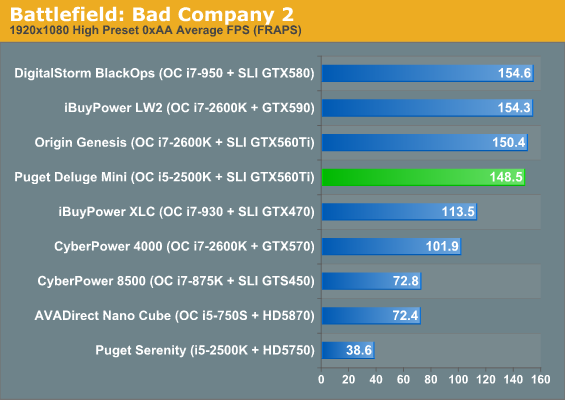
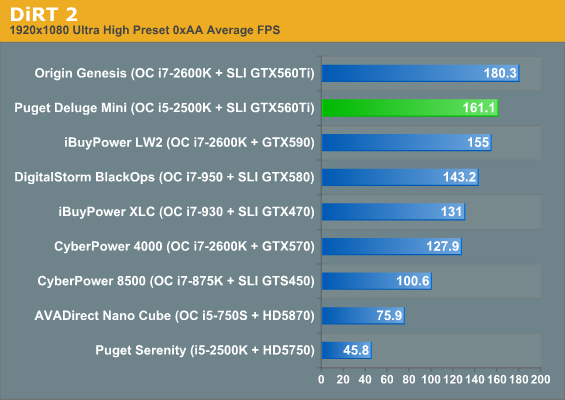

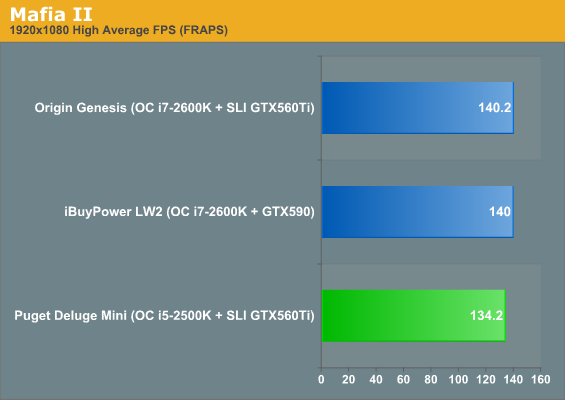
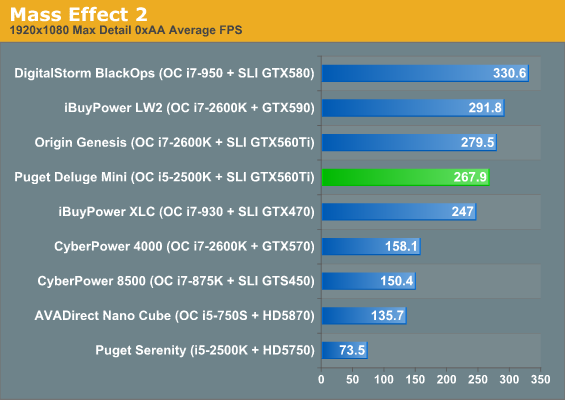
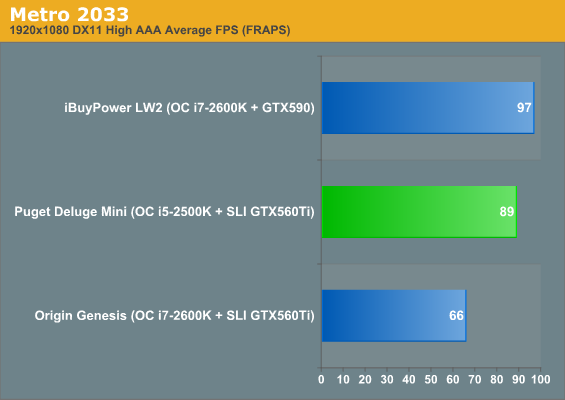
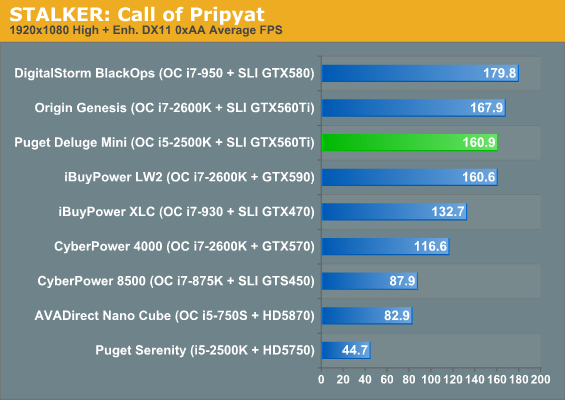
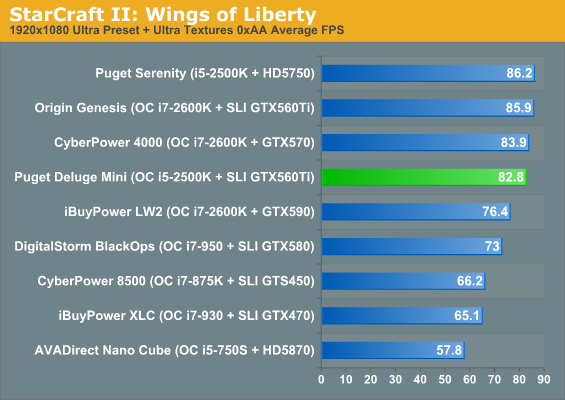
In certain cases that were already CPU-limited, the extra logical cores on the i7-2600K seem to help, but it's at this juncture we should point out a vital difference in how these systems were tested. At our standard 1080p testing, the Origin Genesis was using NVIDIA's 267 series drivers while the Puget Deluge Mini used the older 266 driver; these machines were tested concurrently, and it was actually with the Deluge Mini that we discovered just how dire the situation was for NVIDIA Surround. On 266.66 Surround just plain didn't work, but we didn't discover this until after we'd completed our 1080p testing for the Deluge Mini.
When we went to test the Genesis, we updated to the beta 267 driver right off the bat, which is likely what's causing results in Metro 2033 and STALKER to skew somewhat. This is also a good time to remind you that all of our tests are run thrice to ensure variations are weeded out. Interestingly, the 266 driver actually ran substantially better in Metro 2033 at "High" than the updated 267 driver (and of course now there's a new 270 beta driver available).
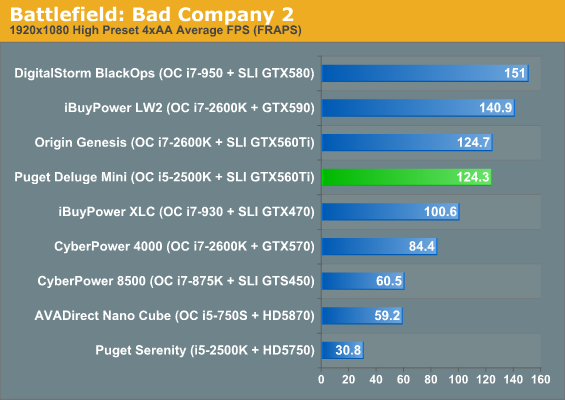
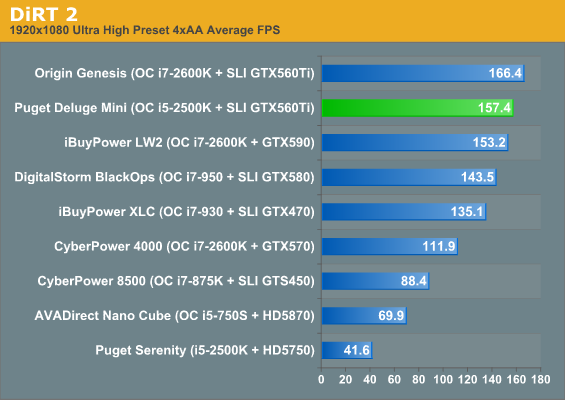
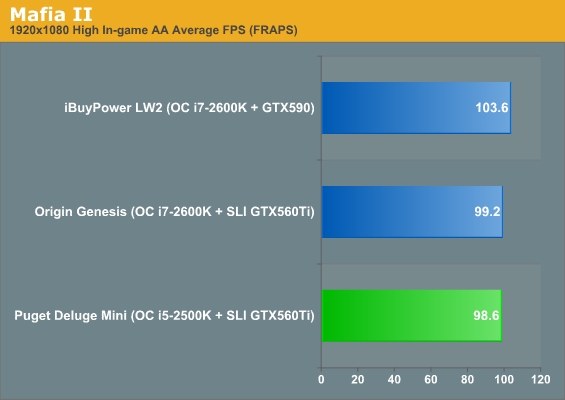
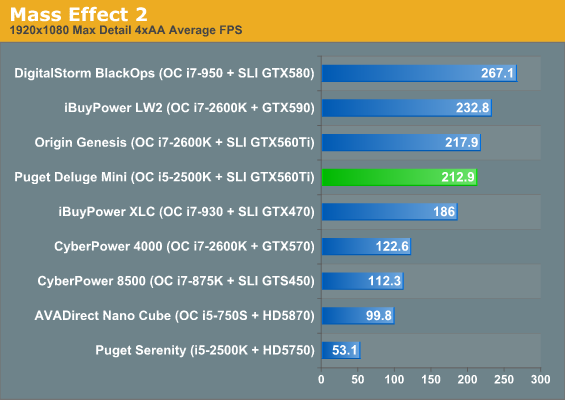
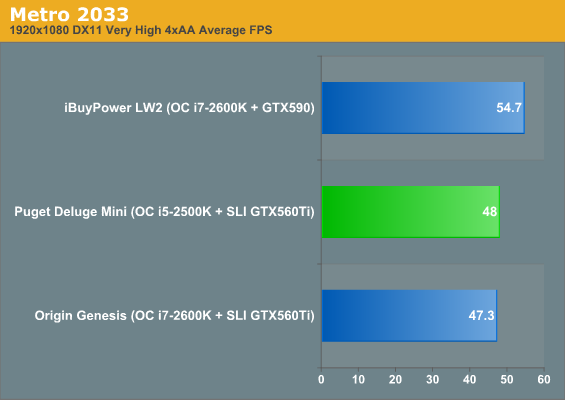
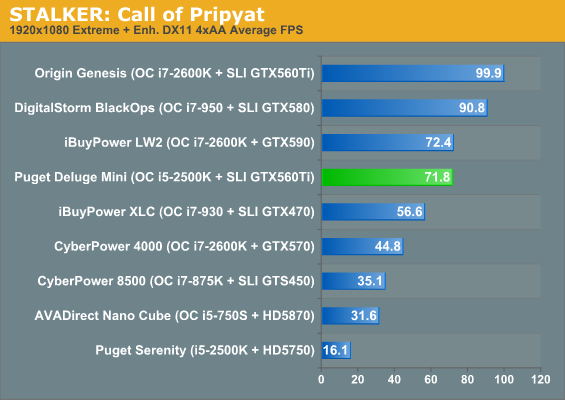
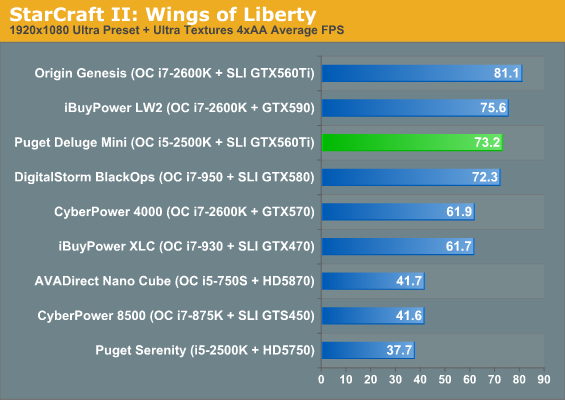
I can't stress this enough: for many of these gaming machines, running at 1080p (even with anti-aliasing) the GPUs are overkill. The two GTX 560 Ti SLI systems essentially bunch up, with Hyper-Threading either producing a gain or taking its cut and the driver difference making its presence known in STALKER, where abnormally high results in the "Night" benchmark skew the average. Let's move to surround gaming to remove the CPU bottleneck.
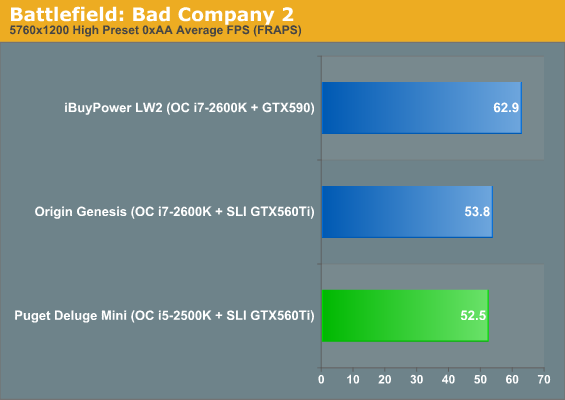

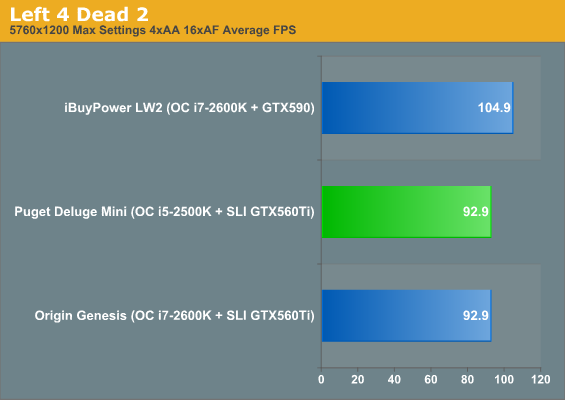
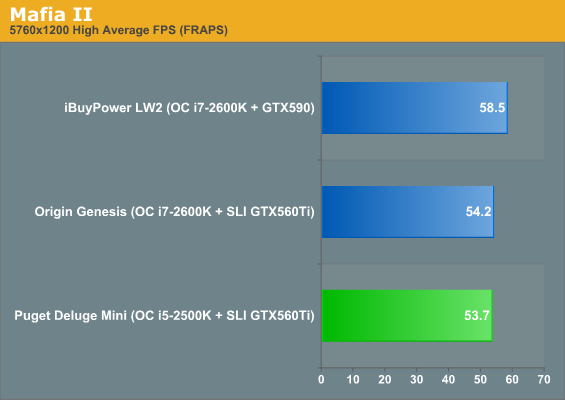

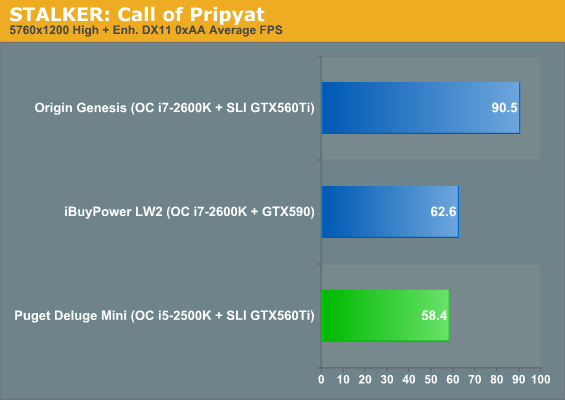
Finally, our surround testing continues to show freakishly favorable results for the Origin Genesis in STALKER, while in every other test the systems essentially fall in line. This is really where multi-GPU solutions shine and we hope to continue adding to these results in the future, but it's also a crime that getting NVIDIA Surround to work properly is as fraught as we discussed in the iBuyPower LAN Warrior II review. Those issues occurred across the board on all of these systems.










25 Comments
View All Comments
Spazweasel - Tuesday, April 5, 2011 - link
Did I miss something? I don't see acoustics charts...ShortyZ - Tuesday, April 5, 2011 - link
Indeed. Let's also disconnect the added side fan, block off the hole and compare heat and noise to demonstrate the benefits.grant2 - Wednesday, April 6, 2011 - link
"That puts their comparatively meager 1-year standard parts warranty into perspective:"Actually: no, it doesn't, not at all. If they really were so confident of their design, they'd offer a longer warranty
"Puget performs extensive reliability testing of hardware on the market and collects massive amounts of data (some of which I've actually been privied to see.)"
Mediocre warranty + showing SOME of their test data to a reviewer is a "privilege"?? Wow you're snowed, Dustin.
METALMORPHASIS - Wednesday, April 6, 2011 - link
You want a better bang,build your own.HangFire - Wednesday, April 6, 2011 - link
Yes, for a better bang for your buck, build your own.When your co worker who doesn't want to fiddle with their system, or want you fiddling with it, but asks for a recommendation on a "really nice" computer, I tell them Puget Sound.
pandemonium - Wednesday, April 6, 2011 - link
Nothing about that case interests me except the actual case itself. I do like the way it efficiently lays out parts inside the mini tower along with the full height intake vent. Plus it looks like it should be a docking station for 7 of 9. Of course, if she came with it I'd have no arguments what-so-ever. ;)Meaker10 - Wednesday, April 6, 2011 - link
You should run 3dmark 11 and both vantage and 11 should be run in xtreme mode.Meaker10 - Wednesday, April 6, 2011 - link
I own a P180 mini and knew there was a lack of airflow to the GFX cards without the use of thermal imaging products LOL.I solved it by creating an intake from the bottom middle of the case where there is a filter.
JPForums - Wednesday, April 6, 2011 - link
While I believe 3DMarks results to be far less relevant than game frame rates, there is a way to make them far more relevant that what is posted here. It should be obvious. When you are comparing setups capable of driving high graphical settings on multi-monitor configurations, there is no way you won't end up CPU limited on a single low resolution monitor.
I see two 1024x768 resolution tests, one 1280x768, and one unmarked which I'll optimistically place at 1280x768 (given that 3DMarks 05 and 06 are very similar to begin with). I also see that the 3DMarks Vantage test is entry level. One would naturally assume that the highest end cards would be most able to differentiate themselves with the highest end tests.
I don't see earlier 3DMarks test as being relevant due to lack of coherency with modern games. Later 3DMarks test are irrelevant in this case due to the fact that were run at resolutions that you never run your game test at.
My suggestion is to use 3DMarks 11 and perhaps Vantage and apply the same rules you use when checking out games. In this article, you ran everything at 1920x1080 and varied some graphics settings at the high end. It looks like you also saw the multi-monitor 5760x1200 as relevant. It would seem to me that the the most relevant resolution to run 3DMarks at (in this article) would be 1920x1080 or 1920x1200. Then, as with the games, vary the settings at the high end. Finally, if you are so inclined (and if the test allows) check out multi-monitor resolutions or higher single monitor resolutions.
In other articles that display gaming performance at lower resolutions, it may be worth checking out those resolutions as well. However, keep in mind the capability of the systems you review when deciding on a single resolution.
HangFire - Wednesday, April 6, 2011 - link
The purpose of these benchmarks is to make most video cards appear obsolete and use obscure features of newer video cards that may or may not appear in games for 3-5 years. In an era of 1080p constrained console game ports, expecting video benchmarks to be relevant is a stretch.Everyone can appreciate a 24-26 inch monitor over a smaller one, and the industry standardizing on 1920x1080 makes such monitors affordable as well. However dual monitors of higher resolution are much more than twice as expensive, and any dual monitor seems an extravagant waste of money when most games do not make good use of them. So, it appears we have arrived at a plateau in video resolutions for a while, where the highest end video cards simply are not necessary, and the benchmarks that drive them, irrelevant.